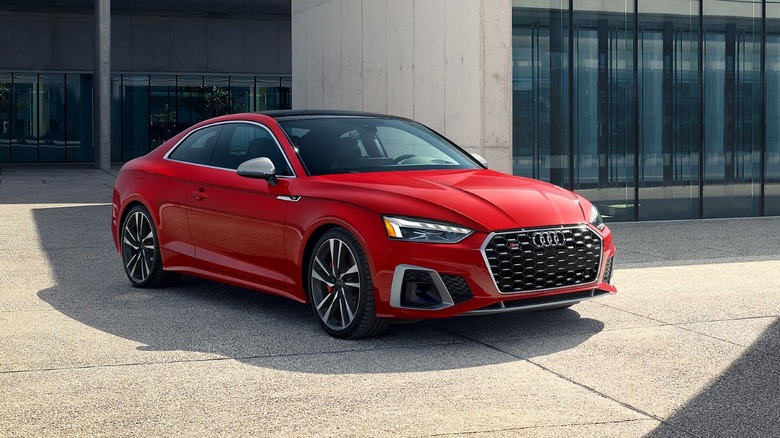What Engine Powers The Audi S5, And How Much Horsepower Does It Have?
Introduced in 2007 ahead of the 2008 model year, the S5 is a sportier version of the Audi A5. As such, it offers a more powerful engine, along with a sport-tuned suspension that gives the chassis a firmer feel, high performance brakes, larger wheels, and stickier tires that are better-suited to its sportiness. It sits between the Audi A5 and the higher-performance RS 5 within the brand's luxury small car lineup, and was initially marketed as a competitor to the BMW M3 and since-discontinued Mercedes-Benz CLK 550. That said, modern S5s have also found formidable competitors in the likes of the BMW 4 Series Gran Coupe M440i, Hyundai Ioniq 5 N, and Acura Integra Type S.
While most discussions about the S5 will understandably steer toward its handsome looks, the performance car has traditionally been offered with engines that are decent enough to get your pulse going. And although the S5 has mostly been powered by Audi's 3.0 TFSI since the 2010 model year, horsepower output has varied over the years due to the use of varying forced induction systems and other forms of assistance. Here's a look at the engines that power the Audi S5 and how much power they make.
What engines do contemporary Audi S5 models have?
To mark the end of the second S5 generation, Audi made a host of changes to the luxurious sporty car, including dropping the S5 coupe and convertible for the 2025 model year. But perhaps more relevant to car shoppers was the introduction of a new S5 Sedan that was made available alongside the returning S5 Sportback. Compared to its older sibling, the S5 Sedan has a turbocharged 3.0-liter V6 that pairs with a 48-volt mild hybrid system to up power to 362 hp, which represents 13 more horsepower over the 349 hp managed by the 2025 S5 Sportback's turbocharged V6. Beyond the Sportback, that output is also enough to make the S5 the most powerful S5 model ever.
To provide some context, all second-generation S5 models – including the Coupe, Sportback, and Cabriolet (convertible) – have been powered by a 349-hp, twin-scroll turbo V6 since the 2018 Audi S5 debuted back in 2017. Before them, their first-gen predecessors had a supercharged 3.0 TFSI V6 engine that made a more modest but still-glorious 333 horsepower between the 2010 and 2017 model years. According to Zeroto60Times data, a 2013 Audi S5 Prestige Coupe with the 333-hp supercharged V6 engine could scoot to 60 mph in around 4.7 seconds and clear the quarter mile in 13.3 ticks. That's 0.3 seconds faster than a 2011 Audi S5 Prestige Convertible, which needed 5.0 seconds to reach the same speed. However, the 2013 Audi S5 Prestige Coupe is about 0.4 seconds slower than a second-generation S5 with the turbocharged V6, taking into account the second-gen Sportback that clocked 60 mph in just 4.3 seconds in a Car and Driver testing.
What about the V8?
The Audi S5 coupe initially debuted with a naturally aspirated 4.2 FSI V8 engine back in 2007. The engine would power the sports car between the 2008 and 2012 model years, making 354 horsepower and 325 pound-feet of torque – which was enough to accelerate it from 0-60 mph in 4.6 seconds and see it reach a top speed of 155 mph. The V8 was also reasonably efficient for such a powerful engine. According to EPA estimates, a 2008 Audi S5 coupe returned 16 mpg city, 22 mpg highway, and 19 mpg combined.
That's slightly better than a 2008 Mercedes-Benz CLK 550 could manage, given its 15 mpg city, 22 mpg highway, and 17 mpg combined return. But, what the CLK 550 lacked in efficiency, it made up for in horsepower, thanks to a larger naturally aspirated 5.5-liter V8 that puts out a whopping 382 hp. As you may know only too well, however, higher horsepower doesn't always translate into better performance on the pavement, and that's true for the CLK 550, seeing as it needs around 5.1 seconds to reach 60 mph and also has a limited top speed of 130 mph, according to KBB data. That makes it slower than the Audi S5 V8 both in terms of top speed and 0-60 mph time.


